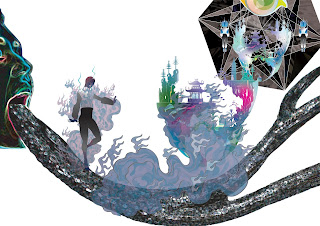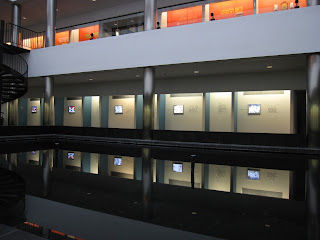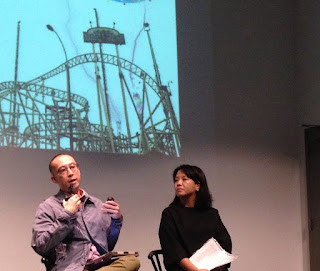"blue trigger" was presented at "repurposing nostalgia", held in a restored shophouse in little india across 2 weekends in january
while surveying the site, i came across 3 colour swatches painted onto a wall in one of the rooms. immediately a connection between the shades of blue, jarman's elegiac film before his death from aids complications & the sense of melancholy over things we've lost to time
the full text, images & links to the online mixtape are reproduced in their entirety, following the installation shot & explanatory note
we managed to get the show included in the programming of art week 2016. many thanks to yen phang for getting me on board this one! appreciations also to mr loh & karen of pocket projects for the space
while surveying the site, i came across 3 colour swatches painted onto a wall in one of the rooms. immediately a connection between the shades of blue, jarman's elegiac film before his death from aids complications & the sense of melancholy over things we've lost to time
the full text, images & links to the online mixtape are reproduced in their entirety, following the installation shot & explanatory note
we managed to get the show included in the programming of art week 2016. many thanks to yen phang for getting me on board this one! appreciations also to mr loh & karen of pocket projects for the space
blue trigger
date_20160103;
iteration_2.0
(2016 -)
Inkjet print on
rice paper & clear acetate, found on-site paint swatches & masking tape
labels, QR code link to mixtapes
After Derek Jarman’s
seminal 1993 film Blue. the colour has been indelibly associated, for the
artist, with saudade. The emotions that accompany this profound sense of
absence (experienced, anticipated or imagined) would be too
nuanced/multi-layered to be reduced to any single hashtag.
Perhaps the
tripartite work consisting of a fictional essay, images & online mixtapes
would offer a more eloquent circumscription of the experience by eliciting a
multiplicity of reactions, conscious or subconscious.
An experiment in
progress, blue trigger is
as much a response to the exhibition site as it is to the artist’s on-going
interrogation of “reality”. In a departure from his mythopoeic works, it takes
the form of a quasi-academic recon on the nature of time & the experience
of loss.
The beast saudade. Blue ghoul. Chimera. Defined as the melancholic
pining for something irretrievably lost or, even, has never been.
Yet what does it
truly feel like?
Suffocating desert
heat. A child’s plaintive tune forgotten upon waking. Your life interminably
static until time jolts ever so slight & something of meaning goes but you
don’t know what.
To me, it isn’t
Cesara Evora or fado that
embodies this elusive bereavement (though it is Portuguese that had it tagged),
but the void circumscribed by 80s big hair band The Motels.
If it could be
conveyed through poetry or song, it surely isn’t by word nor cadence nor
melody. Because it is not in the form, but shadow, where saudade exists. An abyss nothing human is capable of
describing, it can only be evoked scraping around the edge.
Whatever’s lost is
not lost so much to space as time. And time is perhaps the most problematic of
phenomena the human mind can apprehend. Should its structure be reconfigured,
could the demon then be vanquished? Or would one of a different flavour be
conjured?
Base Case: Line Dancing
Convention assumes
time to be a straight line. We perceive it as such, despite Doctor Who’s
assertion it’s all bumpy-wumpy.*
Indeed Kant, in the Critique
of Pure Reason, maintains the
sequential succession of past, present, future reduces time to a
uni-dimensional construct.**
This linearity would seem to be reinforced by the metaphorical water
under the bridge. The impossibility of returning to any point in the past is a
foregone conclusion. Never again will you pass “Go”. Never again will you collect
$200.
Fig. 1:
Limitation of linearity
Existential – &
experiential – mortality are therefore consequence of this restraint on human
freedom. The inevitability of loss is coupled with the impossibility of
returning to that treasured moment. Which makes us makes us all predestined to
experience saudade. In
other words, it is intrinsic to the human condition.
Fig. 2:
Hypothetical alternate timeline
Temporal linearity
also imposes a limit on human knowledge. It disallows the forking off of an
alternate version of ourselves to observe the outcome for the lost person or
thing. This fate unknown invariably generates a more profound sense of saudade.
The multi-valence of
this emotion, over loss experienced & to come, as well as its inexorability
makes this martyred cousin to nostalgia all the more poignant. Till human
technology enables the construction of a TARDIS that lets us ride the
bumpy-wumpiness of time, our perception of linear time will share with saudade a one-way ride over the waterfall.†
Mixtape Track Listing for Base Case @ http://8tracks.com/ren-zi/line-dancing
1. The Motels: Shame
2. Eskobar: Someone New
3. Suzanne Vega: Cracking
4. Tori Amos: Spring Haze
Note: The music that follow the minutes of silence after the listed sequence are to fulfil
8tracks.com’s minimum requirement for each playlist to contain at least 8 pieces of music.
While I consider them “filler”, I’ve nonetheless tried to select music that conveys the
experience of that mode of time/favour of saudade. So enjoy!
Note 2: The tracks will shuffle after your 1st listen. this is so 8tracks.com can stay within the
terms of their music license that doesn’t allow listeners to know the next track. Which, while
confounding for the set I’ve created, turns every listen into a surprise audio party.
Footnotes
*
Doctor Who. (2011). The Impossible Astronaut. "Time isn't a
straight line. It's all… bumpy-wumpy. There's loads of boring stuff. Like
Sundays and Tuesdays and Thursday afternoons."
**
Nadal, Paul. (2009). Of Kant’s Straight Lines. Retrieved 31 Dec 2015
from https://belate.wordpress.com/2010/04/04/of-kant-straight-line/
† The Iguazu Falls runs as a
leitmotif in Wong Kar Wai’s Happy Together (1997), a metaphor for the
inevitable conclusion to Lai & Ho’s turbulent relationship. The penultimate
scene in which Lai visits the majestic falls, after walking away from the
callous Ho, seems to confer upon Lai’s saudade a near-heroic stature. The
South American setting could be further read as a deliberate choice to permeate
the entire movie with an anticipation of a love destined to fail.
Case A: Now (Ever
& Always)
Kant believed,
should time exist as a series of “nows”, it would assume a shape & would
therefore not conform to his uni-dimensional model.* Nonetheless, regardless of
our perception of past-present-future, our experience of time is as a
succession of the present.
This seems to be
borne by Buddhist philosophy, with its emphasis on “being” present: The past,
having already happened, now just exists in the mind & through its effects
on the present. As the future hasn't happened, it is merely mind.**
It can then be said
that consciousness lives in the eternal present. Therefore…
If ta = Now, tb = Now & tc = Now
=> ta = tb
= tc
More so, the
present, the now, having no definite duration, can be infinite. Time could even
be represented by a 3D matrix, in which all events from time immemorial to the
end of time are suspended, almost as if in an agar gel of fate.
All existence &
actions could then be seen as inevitabilities that play out as time shifts from
temporal ordinates ta
to tb to tc. Continuing this temporal space
analogy, our moving from past to future would be akin to walking from points A
to B. In which case, the past (or future) hypothetically wouldn’t be somewhen
unreachable.
This model of time forms the theoretical premise of science fiction epic
Interstellar. Humans from a technologically-advanced future are able to bridge
distant points in space – as well as time – using wormholes & tesseracts.
Placing a wormhole at the edge of the solar system that could be discovered
& accessed by space explorers in the past, they set in motion the chain of
events that enabled Cooper to reach back through time to communicate data to
his daughter Murphy, allowing her to derive the formulae necessary for space-time
travel.†
Fig. 3: The
inevitability of humanity’s escape from a dying Earth, according to space opera
Interstellar
Truly, we have cause for optimism that the bittersweet of saudade would be eradicated from human experience. A
mundane example would be the reunification of Korean families across the
military-ideological chasm of North & South through diplomatic wormholes.
The pace of technological progress, especially in tele-devices allowing
trans-spatial communication also offers hope.
Consider this other
intriguing possibility: Since all time is now, we – like Schrodinger's cat –
exist in a quantum state of superposition, simultaneously forever dead &
forever alive.∞
From the notion of superposition, even without the discovery of cosmic wormholes,
should we ever find ourselves irrevocably torn from that/whom we desire, in the
omnipresent now, we remain united, ever & after.
Mixtape Track Listing for Case A @ http://8tracks.com/ren-zi/now-ever-after
1. Harold Budd & Robin Guthrie: Neil’s Theme
2. Ryuichi Sakamoto: Diabaram
3. Daby Touré: Dendecuba
Footnotes
*
Nadal, Paul. (2009). Of Kant’s Straight Lines. Retrieved 31.12.2015 from
https://belate.wordpress.com/2010/04/04/of-kant-straight-line. “… he [Kant]
does not begin merely with a notion of time as a series of “nows”… For to think
of time as composed of “nows” is already to give it external shape.”
** Lott, Tim. (2012). Off-beat Zen. Retrieved
1.1.2016 from https://aeon.co/essays/alan-watts-the-western-buddhist-who-healed-my-mind.
“The emphasis on the present moment is perhaps [Zen Buddhism’s] most
distinctive characteristic. In our western relationship with time, in which we
compulsively pick over the past in order to learn lessons from it, and then
project into a hypothetical future in which those lessons can be applied, the
present moment has been compressed to a tiny sliver on the clock face between a
vast past and an infinite future. Zen, more than anything else, is about
reclaiming and expanding the present moment.”
† Director: Nolan, Christopher. (2014). Interstellar.
∞ Tegmark, Max. (1997). The
Interpretation of Quantum Mechanics: Many Worlds or Many Words? Retrieved
31.12.2015 from http://space.mit.edu/home/tegmark/quantum.html#immortality.
Case B: Carouself
Let us return to the metaphorical water under the bridge. The river
having made its way to the sea, evaporates. Vapour coalesce into clouds which
fall back to earth as rain, back into the river, flowing under the bridge once
more. Still the river but no more the same.
After drawing a similar understanding, the eponymous protagonist of
Hesse’s opens his heart to the river, hearing in it the voices of humanity,
&, with each listen, arrive at a deeper understanding of cosmic
connectedness.*
The parable of Siddhartha’s iterative spiral path to enlightenment,
mirrors the prevalence of the shape in the periodicity of chemical elements,+ DNA helices, storm vortices, galactic
configuration. This ubiquity led scientists to speculate the spiral to be a
property of what we perceive as “reality”.++
As constituents of a single entity, time cannot be extricated from
space. If the spiral recurs with such frequency in space, it may inform the
shape of time as well.
If time were a spiral, what happens in the past recurs in the future,
albeit somewhat altered. It implies change. One does not return to the same
place where one begins but somewhere similar. A concept that echoes in stellar
recycling,# the
cosmic epochs postulated in Hindu mythology, Mayan world cycles, Buddhist
reincarnation, Nietzschen eternal return.
My 2014 time-based work ouroborous describes my nascent grasp of this temporal model. It marks the
grounding of my practice in a radical typological reading of myth.
Characterised by permanent possibility, goal fulfillment or apocalypse begets,
not the end, but a fresh beginning ad infinitum.
Fig 4. Time spiral in ouroborous
When surveying the space for this work, my attention was caught by the 3
blue swatches on the wall. They sparked, in imagination, a remix of Derek
Jarman’s Blue (1993). In
it, I see him smearing the screen with overdaubs of the colour in various
shades. Ultramarine. Cobalt. Zaffre. Federal & Egyptian blue. Denim.
Midnight. Navy. Prussian & Persian blue. Deep blue. Electric. Phthalo blue.
Indigo & sapphire. Palatinate & Oxford blue. Blue black. A helical
visual narrative over which circles ruminations of life & loss.
Game geeks would be familiar with Time Spiral, an advanced-level of Magic: The Gathering. Its conceptual engine taps into players’
experience/memories of prior levels, evoking a sense of nostalgia through
keywords, mechanics & cards based on previous sets.
So in a spiral model of time, one expects saudade to be ameliorated by future facsimiles of
what-was. Save for the idealist hankering for an exactitude that can never be
replicated. Which creates an inconsolable melancholy raised exponentially by
cycles past & future. Yet this too can be a sufferance so sweet to warrant
casting oneself wholly into the rip that drips viscous rivulets of pathos.
Because feeling, oh boy, is poetry.**
Mixtape Track Listing for Case B @ http://8tracks.com/ren-zi/carouself
1. SQÜRL: Streets of Detroit
2. Clint Mansell & Mogwai: Death is the Road to Awe
Footnotes
* Hesse,
Herman. Translator: Olesch, Gunther et al. (2008). Siddhartha. The
Project Gutenberg EBook of Siddhartha. Retrieved on 2.1.2016 from
http://www.gutenberg.org/files/2500/2500-h/2500-h.htm. “Softly sounded the
river, singing in many voices. …The river sang with a voice of suffering,
longingly it sang, longingly, it flowed towards its goal, lamentingly its voice
sang… Siddhartha made an effort to listen better… For the goal, the river was
heading, Siddhartha saw it hurrying, the river, which consisted of him and his
loved ones and of all people, he had ever seen, all of these waves and waters
were hurrying, suffering, towards goals, many goals, the waterfall, the lake,
the rapids, the sea, and all goals were reached, and every goal was followed by
a new one, and the water turned into vapour and rose to the sky, turned into
rain and poured down from the sky, turned into a source, a stream, a river,
headed forward once again, flowed on once again. But the longing voice had
changed. It still resounded, full of suffering, searching, but other voices
joined it, voices of joy and of suffering, good and bad voices, laughing and
sad ones, a hundred voices, a thousand voices… Already, he could no longer tell
the many voices apart… they all belonged together… everything was one,
everything was intertwined and connected, entangled a thousand times… all of
this together was the world… when he did not tie his soul to any particular
voice and submerged his self into it, but when he heard them all, perceived the
whole, the oneness, then the great song of the thousand voices consisted of a
single word, which was Om: the perfection.”
+ Elmegreen, D M & Elmegreen,
B G. (2014). The Onset of Spiral Structure in the Universe.
Astrophysical Journal.
++ Boeyens, Jan & Thackeray,
Francis. (2014). Number theory and the unity of science. South African
Journal of Science.
# Director: Hornsby, Gaby.
(2012). The Seven Ages of Starlight.
## Press, Eitan. (2012). Time
Spirals and Other Insights Into the Jewish Calendar. Retrieved on 2.1.2016
from
http://www.huffingtonpost.com/eitan-press/time-spirals-and-the-jewish-calendar_b_1513298.html.
**
Paraphrasing the last line from Claire Tham’s short story, Baby, You
Can Drive My Car (1984): “Poetry oh boy is feeling.”





































